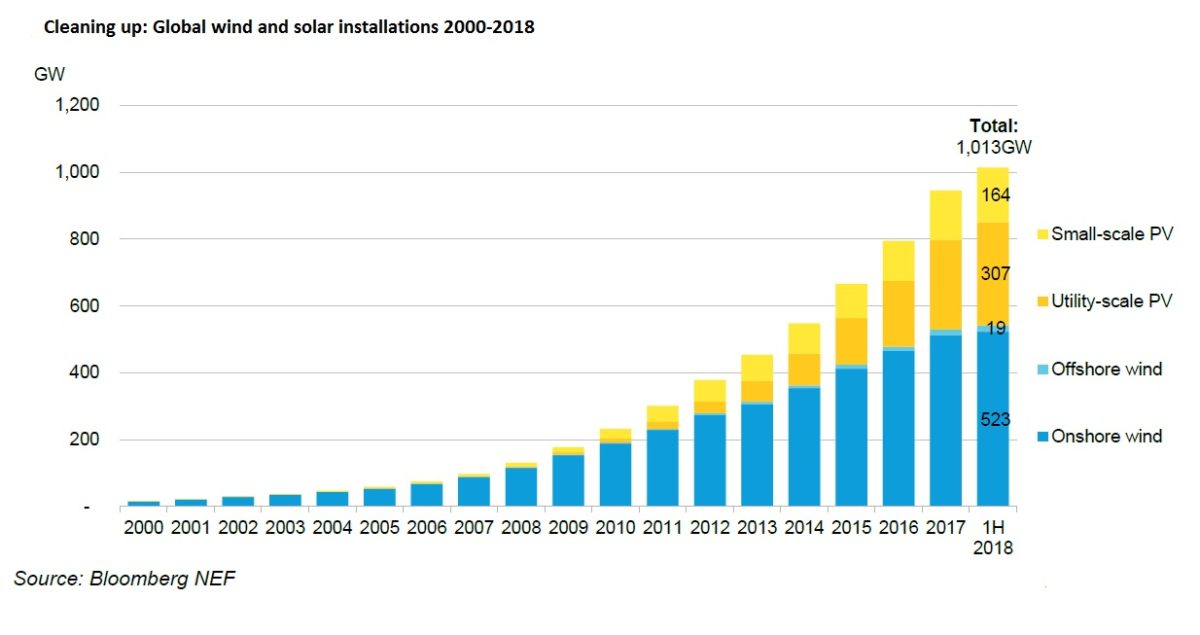BloombergNEF reports that wind and solar energy hit a trillion watts of capacity in the first half of 2018. According to its latest research, a significant uptake in installations in Asia, led by China, enabled this milestone.
Installing this first trillion watts reportedly required an investment amounting to US$2.3 trillion. However, as technology and markets are maturing and adapting, installing the second trillion watts will require an investment of just $1.23 trillion, thus marking a large reduction in costs.
Similarly, the time it took to install the first trillion watts amounted to 40 years. But, with global ambitions increasing and falling prices enabling ever more renewable energy assets to be installed, the analysts believe the second trillion watts will be commissioned as early as 2023.
90% of the one trillion was installed over the course of the last 10 years. BloombergNEF attributes Germany’s pioneering energy market design in the early 2000s, which fostered transparency for investors and bankers, as key to this uptake. Through feed-in-tariffs, like the German “EEG”, return in investment calculations have become much less risky, thus making this type of electricity generation conducive to an increasing number of financial stakeholders.
The analysis further states that wind generation is still maintaining its lead over solar, accounting for 54% of the installed terawatt. BloombergNEF, however, says solar PV could overtake wind power by early 2020. Looking at the data provided, the growth rate of solar PV compared to wind power is immense. In China alone, the analysts expect 1.1. terawatt of solar PV installed by 2050.
“Hitting one terawatt is a tremendous achievement for the wind and solar industries, but as far as we’re concerned, it’s just the start,” said Albert Cheung, BloombergNEF’s head of analysis in London. “Wind and solar are winning the battle for cost-supremacy, so this milestone will be just the first of many.’’
Capacity factors
Total global installed power capacity is 6.2 terawatts, of which one terawatt comprises coal-fired power plants in China alone, the report continued. Wind and solar reaching the same capacity is a good step, but BloombergNEF also calls attention to the fact that different electricity resources have different capacity factors.
The capacity factor determines how close an electricity resource comes to reaching its full theoretical potential. The global average for wind farms, according to BloombergNEF, is about 34%, though some of the best sites in the world prompt a 60% capacity factor. Solar plus tracking reportedly ranges from 10% in the U.K., to 19% in the U.S. and 24% in Chile’s Atacama Desert. Meanwhile, it estimates that coal-fired power plants have a capacity factor of 40%, while nuclear power plants could reach 80% and above.
As storage technologies are becoming cheaper and more advanced, market designs are adapting to them, with grid operators and utilities seeing the potential. Grid operators can tap more renewable energy resources, as this will not affect grid stability, ultimately increasing renewable energy's capacity factors.
“As we get into the second and third terawatts, energy storage is going to become much more important,’’ Cheung said. “That’s where we see a lot of investment and innovation right now.’’
This content is protected by copyright and may not be reused. If you want to cooperate with us and would like to reuse some of our content, please contact: editors@pv-magazine.com.




23% of American households belong to Homeowners Associations, and all of them restrict the use of solar energy to various degrees. We were allowed to install solar panels on the back roof of our house only because it’s facing south, but our neighbors on the opposite side of the street cannot use solar energy.